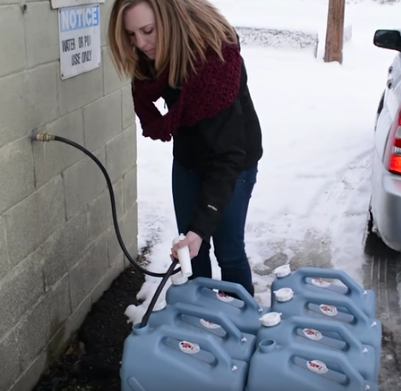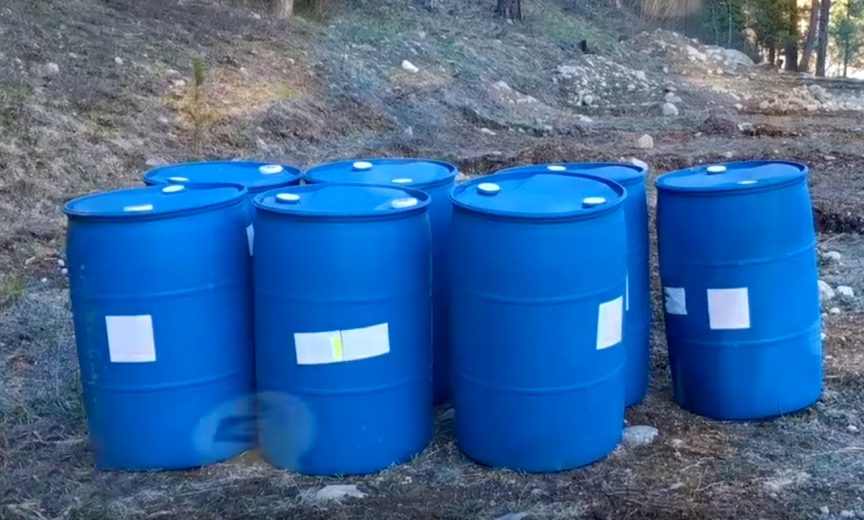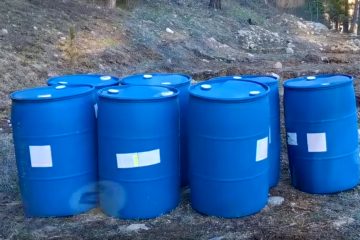Pure Living for Life put together a great video for off-grid water solutions that we’d like to share with you. They cover many options regarding off-grid water solutions such as rain water harvesting, cisterns, wells, and more in this 11 minute video.
Off-Grid Water Solutions Video Transcript
Jesse: Hey, thanks for joining us for this “Starting Your Off-Grid Water Solutions” video. We wanted to kind of talk a little about the process that we’ve been going through as we move toward a more permanent water solution. And we’ve kind of tried a few things. We’re doing something right now that’s working really good and we’ve been kind of testing if we can tip toe to more interim solutions or if we should just go whole hog and step up to a permanent water solution. So we thought we’d talk with you a little about some of the things we’ve tried and some of the things we’ve learned from that, and then how it can maybe help you just like it’s helped us kind of shape our opinion about what steps we should take toward a permanent water solution.
 Alyssa: When we first moved to our land we thought that one of the things we were going to do immediately was drill a well. But because it’s so expensive and there’s really never a guarantee that you’re going to hit water, or if so, how deep, just how much money it’s going to be, we decided that we didn’t want to do that right away. Therefore we decided to go with these blue water jugs. And we actually have an entire video on why these jugs, why this exact size and not a gallon heavier.
Alyssa: When we first moved to our land we thought that one of the things we were going to do immediately was drill a well. But because it’s so expensive and there’s really never a guarantee that you’re going to hit water, or if so, how deep, just how much money it’s going to be, we decided that we didn’t want to do that right away. Therefore we decided to go with these blue water jugs. And we actually have an entire video on why these jugs, why this exact size and not a gallon heavier.
And this has been working really well for us because it costs us literally a quarter to fill all of them up. We have about eight or so. I can manage it myself. It’s really easy to put into the RV and it really kind of circumvented the need to go with a larger, more elaborate water system right out of the gate. Now that is something very important that we’re working towards, but again this video is all about kind of what we’ve tried and why we’re doing what we’re doing.
Jesse: Yeah, we’ve been talking about and we kind of had some opportunities to do something more semi-permanent, and we’ve kind of done some cost comparisons. What we’re doing is measuring the cost per gallon. And so we kind of ran into some things like rain barrels. We thought we’d try it because the cost per gallon seemed really favorable, but there’s been a lot of lessons learned in that. And that kind of threw us back into more permanent water solutions and kind of the costs and trial and error of those. So we thought we’d kind of talk about some of those now.
So in our quest to find an affordable interim water solution, we thought we would give the rain barrel collection system a try. We do get quite a bit of rain. In fact this last winter we had some pretty torrential downpours. And it was actually originally part of the plan with our hot tub deck to roof the deck and then do water collection off of the roof. It sounded like a really great system. Well, we finally got a chance to get some rain barrels and before we got really deep into this system we thought we would do a little bit of testing on our property just to see what the execution of it all looks like.
So we set up a tarp and tried to collect some rain. But there’s one…well, there’s two major problems with our property. One, it’s pretty windy, and that’s a problem with tarps. So because we’re not going to roof the hot tub deck, the only real way to efficiently collect the rain would be a tarping system. Sure, we can go elaborate and build roofs and we can do all kinds of crazy stuff but this is getting to be ridiculous. The efficiency of the rain barrel is gone. So we did do the tarp, we did collect some rain, it did work. But the effort and the stress and all of that was just not justified in what amount of water we would collect.
So while it sounds really authentic or romantic to get this rain collection system going, for us it’s not super practical. In fact, as you can see right now, the wind is blowing. This would destroy whatever rain collection system we could affordably set up. But we were able to validate the gravity feed system off of these, which helps us to understand better how much elevation we need to create the water pressure that we need using gravity feed, which is something we want to do. Sure, yes, everybody watching this video knows that there’s calculators our there. You can calculate it. But practicality, like doing it, is worth a lot. So the rain barrel was able to help us to determine that the water pressure we need is actually usable. So that’s really great.
Alyssa: The other big problem we realized we were going to run into with rain barrels was that of freezing. For us it’s…we’re very prone to freezing temperatures during the wet season, which is winter. So we can experience freezing any time from October to May. And in that case we’d probably really want to bury our rain barrels or build some sort of like root cellar for them. So quickly the costs can just get out of control. So we’re not opposed to doing rain barrels. We’d love to set them up in the future. But when we’re talking about the next step in our permanent water solution, we really feel that this is more of a project to save for a rainy day.
Jesse: So summing up rain barrels, it’s not a practical solution for us. If you’re in a warm climate, we can see it being very practical. You’re probably also gonna get a lot of different rain cycles than we get so you could collect more of that usable water. The reason rain barrels really weren’t practical for us is the collection system’s not efficient and the cost of implementation is horrendous because by the time we built some sort of structure to protect the barrels to try to keep them from freezing, put all the efforts into trying to collect the water, etc. It’s just not worth it per gallon. So we’d like to talk about some of the other things that we’ve looked at that make more sense for our application.
The next water solution that we wanted to talk about is cisterns, and there’s a couple of different solutions here. One can be an above ground cistern, and then there’s also tanks like these that are designed to be buried. Cisterns are a great water solution because they can provide months of water in one fill up. Whether you fill them with rain, snow collection, you have water delivered or you decide to drill a well, we’ll talk about wells in just a minute, but this is a great interim solution even if you decide to drill a well because wells on demand can put a lot of strain on your pump and they can’t always be the most efficient solution.
But a cistern, you can often draw off of, even if your well fills the cistern. And that actually puts a lot less strain on your well system if you have to simply recover the water that’s been used. For us this also makes sense because we’re in a freezing climate, which is what we mentioned about rain barrels. It doesn’t really work for us. So what we’re looking at is a variable cistern that we can put below the frost line so that we have access to our water all year round instead of just in the summer. It’s funny, a lot of people we’ve talked to about living off the grid, they say, “Just put heat tape on it.” That’s how they recommend that we keep our things from freezing, but if you know anything about living off-grid, we don’t have power, which makes that not a solution.
So you have to think about these things as you’re considering your water solution. For us, living off-grid, no power means that our water supply needs to go underground. Above ground tanks are a problem because they’re often exposed to sunlight and heat, which can make treatment a bit of a challenge. So there’s another benefit to having your water system underground.
One quick note about above-ground tanks is they are portable a lot of times. So if you were to put them in a pick up or a on trailer, a lot of people will actually go get their own water from a community water source. And they’re usually substantially more affordable than anything that can be buried just because they don’t have to be as strong. Underground tanks are much more rigid and they require more material so they’re going to cost a lot more. So if you’re looking for an above-the-ground water solution, we see a lot of people that have these tanks, both as a storage tank and as a transportation tank.
So just a quick comment about above-ground tanks. So that’s a little bit about cisterns and a little about why we’ll probably be going this route before we drill a well because there’s no risk involved. You simply install the tank, we have water delivered and we have several months of water on hand. So the last thing we’d like to talk about is wells. And it’s a very sensitive topic for a lot of people and there’s no right or wrong answer. The thing about a well is you need to do research in your area.
For our area, there are wells in our area, but it’s very hit and miss because we’re in a glacial outcropping. And so drilling 50 feet away can make a huge difference. And the thing about well drilling is it’s a bit of a gamble. Even with all the modern technology and well-witchers and all this stuff, there’s still no guarantee that you’re gonna get water. So, for us, drilling a well is not excluded from our plan, but being as it’s a gamble, it wasn’t something that we prioritized highly. However, if you’re in an area with a really high water table and everybody around you has wells, well, it might make sense to just go straight for a well because it might just be a couple $3,000 and you’ll have access to water.
So our point is we’re not trying to tell people not to get wells first, but we’re simply saying, do your research and you may find depending on your area that a well might be the last thing that you want to do. As far as our cistern goes, having water delivered is very affordable so there’s no need to risk $10,000, $15,000, $20,000, $30,000 hoping to get water when water can be brought to us very easily on a very interim basis. That’s a little bit of our thinking about wells, and again just do research in your area to make a decision about whether it’s a good idea for you.
Alyssa: So this sums up our water video. This is not the end all, be all off-grid water video. It’s simply some of the things that are going through our minds and some of the things that we’re considering doing. There is no one right answer for every person or every property. It really depends on what your short-terms goals are, your long-terms goals, the setup of your property. And it’s really about weighing the pros and cons of every solution and balancing your short-term needs with your long-term needs, what your budget is, things like that.
Jesse: Yeah, and we feel like there’s a lot of information available online, so doing some proper research, there’s some really powerful resources out there. So, do some research and kind of ask around a little bit. But we would definitely encourage you to kind of be open minded about water. Everybody we’ve talked to kind of like, “Oh, are you going to get a well? Wells!” Guess what, a well is not the only way to get water, just so you know. This video really is about practicality. So for us, having water delivered every three months is not a massive inconvenience. And you know we’re not really doomsday preppers, so we’re not worried about the world ending tomorrow and we’re gonna die from dehydration.
Alyssa: Does that make us 110% self-sufficient? No,w e’re not there today. But the whole goal is we’re working towards being more and more self-sufficient every day. So every day we’re trying to up-level our water situation, if that makes sense.
Jesse: Yeah. And something we’ve learned is that you want everything, but you can’t have everything. So we’re trying to find ways to balance out today’s needs with tomorrow’s needs. We feel like there’s a lot of different ways to solve the same problem but hopefully this video gave you some ideas about short-term, long-term stuff, and hopefully we’ll do more videos in the future about how this worked out for us and any good or bad things we’ve learned from it.
Alyssa: If you want to learn more about the development of our off-grid homestead and some of the things that we’re working on, such as the building of our timber frame barn, the building of a hot tub and a hot tub deck, starting our garden, composting, things like that, then be sure to follow our blog. It’s purelivingforlife.com. Also feel free to subscribe to our YouTube channel. We would really appreciate it. We’ll put a button right here, so click on that. And then we also post a lot of real-time updates on our Facebook page, as well as our Instagram channel. And these things don’t always make it to YouTube or even the blog. So we’ll put links to all those channels in the description below and we’ll see you in the next video.
Last modified: April 21, 2025








